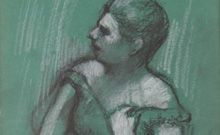
On Authenticating a Potential Degas Drawing
One of the most interesting parts of this business is the detective work required to investigate and authenticate a potentially high value work of art. Recently a client came in with this pastel drawing on paper of a ballerina signed Degas. It had been purchased at a small auction house in New York City in the early 1960s. To look at, it appeared more or less “right,” trade parlance for authentic and/or original. There was a small area on the back of the drawing where some notation had been erased or removed which raised a small red flag, but it still looked good enough to pursue. Our client was interested in having us handle its sale if an original so we set to work to see if it was the real thing.

It is customary for important artists of significant historic interest to be researched and studied by art historians and students of art history. A part of that academic work is the compilation of a catalogue raisonné, a documentation in book form of every work of art known to have been created by an artist. Sometimes, if an artist has been particularly prolific in several mediums, there will be separate catalogues for each medium.
In this case we first went to the catalogue raisonné of works on paper and drawing of Edgar Degas at the Skidmore College Lucy ScribnerLibrary. A thorough search revealed no work that resembled ours—not good, but not necessarily bad. It would be easiest if the work was documented and/or had some known history, but works of art turn up on the marketplace regularly that are authentic and undocumented. In those cases, established authorities on the artist are contacted for an opinion and, if favorable, charge a fee for a letter of expertization attesting to the expert’s opinion that the work of art is an original work by the artist.

We contacted our good friend Paul Tucker, formerly of the Museum of Fine Arts, Boston, noted authority on Claude Monet, for his thoughts about the piece, as well as a referral to a Degas expert or experts. He replied that although the figure was remarkably awkward and ugly—pointing out the poorly rendered right arm—this might work in its favor because “who would imitate Degas with such an unattractive model so crudely drawn?” (poor girl!). He referred us to two Degas authorities to pursue our inquiries with.
We attempted to contact both experts by telephone unsuccessfully. I find it usually more productive to speak with someone first and make a connection before sending unsolicited material. Neither was available and we took a chance and emailed both with images. We received a response from Richard Kendall at the Clark Institute in Williamstown, Massachusetts. Unfortunately, he let us know that in his opinion the work was not by Edgar Degas. If needed, he would supply a detailed analysis of why he believed that to be the case. This was not the news I was looking forward to relay to our client.

I must say Mr Kendall was refreshingly professional and prompt in all of his communications, an uncommon trait in the art and auction world where specialists are often deluged with well-meant inquiries from hopeful people with items that are worth very little and/or have no commercial interest. The Clark Institute is a gem of a museum in the Berkshires, housing a world class collection of art in a beautiful white marble neo-classical structure. A perfect and satisfying day trip from Saratoga or the capital region.
The end result for our client was not what was hoped for. If authentic, an original pastel drawing of this size could sell for well over $100,000. In this case the value of the drawing as an interesting decorative picture might be a few hundred dollars. Could there still be a chance that the picture might have been done by Degas? A very small one, and here is where the art marketplace can get controversial. All it takes is an “expert” to say that in their opinion a work is authentic. The marketplace may then treat that object as such until such time as another “expert” decides that that is not the case. There are numerous examples of works of art over the years that have been determined to be authentic and were discovered at a later time not to be. This is why a known history of a work is so important, either from inclusion in a catalogue raisonné and/or a detailed history of ownership or descent through a family. This takes the guesswork and conjecture out of the picture and gives buyers the full confidence they need to pay an appropriate sum for an important work of art.
